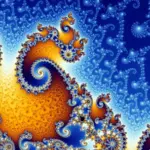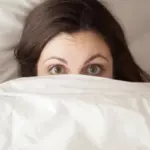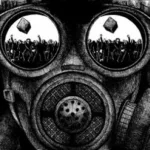
When the word hallucination came into common use in the early 1500s, it simply indicated a fainting, a “wandering mind.” It was only in the 1800s that Jean-Etienne Esquirol, a French psychiatrist, gave the term its current meaning: in general, they are defined as perceptions that have their origin in the absence of any external reality; It is, for example, seeing or hearing things that do not exist. Through this PsychologyFor article we will be able to discover the various types of hallucinations, the causes of these phenomena and some examples.
What are hallucinations
A hallucination is a false sensory perception that occurs in the absence of a correlated sensory stimulus; They are virtually always abnormal and can involve any of the five senses, although auditory and visual hallucinations are the most common. Hallucination is a mental representation that:
- Have a perceptual format image or detail.
- It comes from the conception and memory functions.
- It is exchanged by the subject for a perception attributed to external sources (as a subject, not as a physical body).
- It is associated with a involuntary experience sometimes intrusive, sometimes expected, sometimes still abruptly obstructing the course of thought or speech.
- Can have elementary hallucinogenic symptoms (flashes, geometric figures, sounds, smells, etc.) or complex (voices that speak about the subject, threatening figures that observe, etc.).
Causes of hallucinations
Hallucinations are fundamental symptoms of different psychopathological conditions, but the presence of hallucinations does not necessarily imply that the person who manifests them is psychotic: they can be considered a psychotic symptom when the person is awake and fully alert.
Why do hallucinations occur? Since there is no external stimulation, sensory stimulation is exclusively internal (cerebral) and is, in general, a symptom of severe psychic pathologies such as schizophrenia, paraphrenia, severe depression and mania. It can also occur in subjects without any psychological disorder, after a long sleep deprivation he medication consumption (some medications that cause hallucinations are antiparkinsonian medications) or drugs (LSD or other hallucinogens); still; hallucinations may appear in the chronic alcoholism (delirium tremens and alcoholic hallucinations), in organic mental disorders and in some forms of epilepsy (temporary).
Mental state in which hallucinations occur
For those who live them, hallucinations seem very real, can imitate perception in all its aspects, starting with the way they project themselves into the outside world. The hallucinated individual is convinced that the object he sees and feels is a reality; He misidentifies the memories of his past and his past fantasies, translating both into a current situation and attributing to them an existence that seems independent of himself, while he tends to attribute a automatic, involuntary and abnormal character to the hallucinatory experience.
Hallucinations are defined in the DSM-V as perceptual experiences similar that they occur without an external stimulus and that are not under voluntary control; It is also specified that hallucinations must occur in the context of an intact sensorium, since those that occur during sleep (hypnagogic) or during awakening (hypnopompic) are considered within the range of normal experiences. These common sensory experiences are not true hallucinations, and therefore are not pathological; They are best defined as a fruit of the imagination.
Hallucinations, furthermore, must be distinguished from illusions, which represent mere misinterpretations of real sensory stimuli; They are common and generally non-pathological. Hallucinations, in fact, have the clarity and impact of true perceptions but without the external stimulation of the relevant sensory organ. To give an example, those who “hear voices” perceive a voice that comes from outside and that generally says sensible phrases and words.
Types of hallucinations and examples
Hallucinations, according to Baillarger’s scheme, are classified into two groups: psychosensory and psychic. Within each of these groups we find several types of hallucinations depending on the sense they affect, in the case of psychosensory ones. Below we will see the most common types of hallucinations and examples of the different types of hallucinations.
1. Psychosensory hallucinations
Psychosensory hallucinations They have precise sensory attributes and can affect all sensory activities, so you have visual, olfactory, gustatory, acoustic, tactile hallucinations, etc. Below we will see each of these types.
2. Visual hallucinations
Visual hallucinations can be elementary, and refer to simple phenomena such as colors, lights, objects, or refer to complex, moving scenes. There are several types of visual experiences, such as:
- The dysmegaloscopic hallucinations: variation in the size of objects or people.
- The hallucinations zooptics: small insects or animals are seen in the environment or on the body.
- The hallucinations autoscopic: see the body and face from the outside.
- The hallucinations with synesthesia: They mix sensory channels, such as hearing the sound of green.
Visual hallucinations often indicate the presence of a psychotic disorder substance-induced, or a psychotic disorder due to another medical condition; They can also appear in the context of a major neurocognitive disorder (dementia) or delirium.
3. Auditory (or acoustic) hallucinations
In the case of elementary auditory hallucinations, the subject perceives sounds, noises, whistles, musical gestures, etc. which can be distinguished from symptoms caused by acoustic damage or diseases of the hearing system, such as tinnitus or ringing. Sometimes, in delirious patients, elemental hallucinations They can be inserted into secondary delusional elaborations. For example: a person hears a whistle and is convinced that people are whistling at him to say bad things to him. Is about complex auditory hallucinations when the subject perceives different voices and verbal content.
4. Olfactory hallucinations
The simple olfactory hallucinations They may be typical of focal (temporal lobe) or systemic neurological diseases (for example, the smell of burning rubber typically reported in epileptic aura). More often, they are inserted into delusional calculations: for example, a patient who when in public smells the smell of excrement and is convinced that others attribute it to him.
5. Gustatory hallucinations
The gustatory hallucinations on the other hand, are reported as sour or nauseating flavors, with patients thinking they are poisoned or that someone is putting medicine in their food.
6. Somatic hallucinations
Somatic hallucinations affect the perception of one’s own body, and it is not easy to distinguish true sensations interpreted in a delusional way from false perceptions, since there is no way to distinguish them objectively. Among somatic hallucinations we can distinguish:
- Kinesthetic hallucinations: abnormal sensations of the whole body (perceived as wooden, glass, decaying) or parts of it (the limbs are deformed, the viscera invaded by animals). Kinesthetic hallucinations related to the sexual sphere are also frequent (the patient perceives the experience of floating, masturbation, direct or distant penetration).
- Tactile and thermal hallucinations: perception of touches, tingling or sensations of cold, heat, wetness (water hallucinations), electric shocks (apt hallucinations).
- Kinesthetic or motor hallucinations: perception of movement in the absence of real movements. Movement can be spontaneous or imposed (the patient feels compelled to act or perform actions).
7. Psychic hallucinations
In psychic hallucinations, the hallucinatory activity is experienced by the subject not as a sensory impression, but as thought or feeling. For example, internal voices, echo of thought. The latter are also called pseudohallucinations because they lack that sensory character that should be precisely hallucinatory phenomena. Below we will see the modalities that we can find within this type of hallucinations.
8. Verbal hallucinations
Within verbal hallucinations, we can find some variants. The complex verbal hallucinations are commonly called “voices”, typical of some mental disorders such as schizophrenia, severe depression and mania. Voices have different characteristics and ways of being reported by patients: they can be commented, offensive, imperative or commanding, echoing in thought. In verbal hallucinations there may be spatial differences, so Voices can come from outside, but also from inside of the individual, and be experienced by the subject as imposed, alien, intrusive, strange to themselves. Furthermore, voices can be characterized by the identity of the speaker, which can also be identified: often the speaker has an important subjective meaning for the individual, in addition to a certain authority and power and what he says makes sense (it could be God, a saint, the devil, a deceased or living relative, etc.).
9. Pseudohallucinations
For the British authors, this type of hallucinations is a hallucination without the experience of external perception but experienced inside the mind; the subject recognizes the strangeness and non-correspondence with forms of reality. It is difficult here not to think that such psychic phenomena are nothing more than common mental images turned obsessive and referred to by the subject as intrusive, non-voluntary and imposed.
10. Hypnagogic hallucinations
In addition to the previous classification of hallucinations, we find other types of hallucinations, such as hypnagogic hallucinations. The hypnagogic state is the state of consciousness of transition from wakefulness to sleep and among the mental phenomena that can occur within this state, hypnagogic hallucinations are precisely intense, vivid experiences that occur at the beginning of a period of sleep and often occur together with hypnagogic paralyses. This phase lasts from a few seconds to several minutes in which some or all of the senses, but especially sight, hearing and touch, may be affected and it is often very difficult for the subject to distinguish the hallucination from reality.
11. Hypnopompic hallucinations
During the hypnopompic stage, the psychophysiological state that leads from sleep to wakefulness, sensory psychic phenomena can occur (particularly visual and auditory but sometimes olfactory and tactile) that can often, due to their vividness, be perceived as real. During the hallucinations hypnopompiche You can have the sensation, for example, of feeling called by other people, or in more traumatic cases, experience the presence of one or more intruders in the bedroom. The hallucinations hypnomamancers They sometimes occur in association with sleep paralysis. One of the most common examples of hypnopompic hallucinations is seeing spiders when you wake up.
12. Functional hallucinations
A functional hallucination can be defined as false perception when a real stimulus is perceived, since hallucinations derive functions from stimuli. The subject has hallucinations when a sensory character is dominant with respect to the rest of the cognitive activity.
13. Reflected hallucination
Reflected hallucination is hallucination in a sensory mode when something is perceived in a different modality. An example of a reflected hallucination would be: the subject sees a photo of a Ferrari and perceives the typical roar of the engine.
14. Extracampine hallucinations
In extracampal hallucinations, the hallucinations are perceived outside the perceptual field. Some examples of extracampal or extracampine hallucinations are: the subject sees his back, hears noises from tens of hundreds of kilometers away…
15. Vivid hallucinations
These types of hallucinations are vivid hallucinations, but considered false by the subject. It is typical of neurological disorders, mostly temporal and occipital areas, or brain stem lesions.
16. Dissociative hallucinations
Dissociative hallucinations are usually visual hallucinations and usually occur in states of intense emotional turmoil, such as recent bereavement or after emotional trauma. These types of hallucinations are considered altered states of consciousness without being a psychotic disorder.
This article is merely informative, at PsychologyFor we do not have the power to make a diagnosis or recommend a treatment. We invite you to go to a psychologist to treat your particular case.
If you want to read more articles similar to Types of hallucinations: causes and examples we recommend that you enter our Clinical Psychology category.
Bibliography
- Dell’Erba, G., Nuzzo, E. (2020). Clinical psychology arguments. Romagnano al Monte, SA: Sprint Edizioni.
- Fasullo, S. (2011). Diagnosis and psychiatric therapy.Padua: Webster.
- Hales, R.E., Yudofsky, S.C., Weiss Roberts, L. (2013). The American Psychiatric Publishing Textbook of Psychiatry. Arlington, VA: American Psychiatric Publishing.
- Morrison, J. (2014). DSM-5 Made Easy. The clinician’s guide to diagnosis. New York: The Guilford Press.
- Pacifico, R., Riccardi, I., Stratta, P., Rossi, A. (2008). Psychopathology of auditory verbal hallucinations. Italian Giornale of Psychopathology14:413-424.
- Pellegrino, A., Bassi, S., Esposito, F.P. (2019). I will investigate the occult. Foundations of clinical criminology and investigative journalism applied to esotericism. Milan: Libraio Editore.
- Sacks, O. (2013). Allucinations. Milan: Adelphi.








